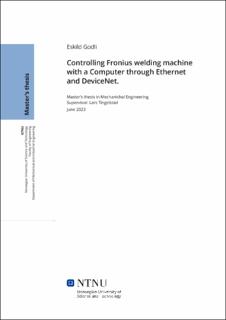| dc.contributor.advisor | Tingelstad, Lars | |
| dc.contributor.author | Godli, Eskild | |
| dc.date.accessioned | 2023-10-05T17:21:23Z | |
| dc.date.available | 2023-10-05T17:21:23Z | |
| dc.date.issued | 2023 | |
| dc.identifier | no.ntnu:inspera:146977797:35324971 | |
| dc.identifier.uri | https://hdl.handle.net/11250/3094628 | |
| dc.description.abstract | Å programmere robotisert sveising av komplekse deler gjennom en robotkontroller byr på betydelige utfordringer. Integreringen av roboten i ROS2 forenkler programmeringsprosessen, noe som gjør simulering og planlegging av sveisebaner mer rett frem. Denne forbedringen krever ikke bare kontroll over roboten, men også over sveiseapparatet. For å imøtekomme dette kravet, er det utviklet et system for å håndtere sveiseapparatene som brukes til robotisert sveising ved NTNUs laboratorium. Tilnærmingen innebærer å koble sveiseapparatet til en PLS via DeviceNet-protokollen, som etterligner rollen til robotkontrolleren, mens PLS-en styres av en datamaskin via OPC UAprotokollen over en Ethernet-forbindelse.
Videre er det gitt en omfattende, trinnvis veiledning for konfigurering og programmering av løsningen. Denne veiledningen er ment å bidra til implementeringen av løsningen i flere robotceller innenfor laboratoriet. For å vurdere funksjonaliteten til den utviklede løsningen, er det utført en serie tester. Resultatene fra disse testene indikerer at løsningen er i stand til å kontrollere forskjellige styringsvariabler effektivt, og dette blir for det meste oppnådd på en tidsriktig måte. | |
| dc.description.abstract | Programming the robotic welding of complex parts through a robot controller poses notable challenges. Incorporating the robot into ROS2 streamlines the programming process, making the simulation and planning of welding paths more straightforward. This advancement demands not only the control over the robot but also of the welding apparatus. A system to manage the welding apparatuses used for robotic welding at NTNU’s laboratory has been developed to cater to this requirement. The approach entails connecting the welding apparatus to a PLC through the DeviceNet protocol, which emulates the role of the robot controller, while a computer controls the PLC via the OPC UA protocol over an Ethernet connection.
Furthermore, a comprehensive, step-by-step guide for configuring and programming the solution has been provided. This guide is intended to aid in deploying the solution across multiple robotic cells within the laboratory. A set of tests has been carried out to assess the functionality of the developed solution. The results of these tests indicate that the solution is capable of effectively controlling various control variables and that this is achieved in a timely manner for the most part. | |
| dc.language | eng | |
| dc.publisher | NTNU | |
| dc.title | Controlling Fronius welding machine with a Computer through Ethernet and DeviceNet. | |
| dc.type | Master thesis | |
